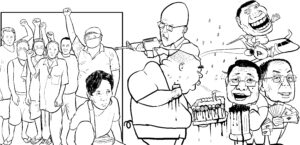The revolution takes root in Niyog

Opening new territories, or doing expansion work in an area, is a difficult but challenging task of the people’s army. In Negros, one such place is Niyog, a barrio in the island’s hinterlands. Almost all residents here are poor peasants. Some are farmworkers. They plant coconuts and produce copra.
At the outset of expansion work, a unit invariably faces challenges. But by firmly grasping mass line, constantly conducting investigation and upholding military discipline, the Red fighters will be able to organize and establish mass organizations from which Red power will grow.
The first thing the comrades did in Niyog was find a good site to encamp outside the community. Since they didn’t know anybody in the area, the comrades became creative in finding food, and competed in catching the most frogs and crabs, and gathering wild vegetables and others.
The people of Niyog were not only unaware of the NPA, they were fed with lies by the AFP. The comrades knew that Niyog residents will be uneasy of the NPA as the AFP had told them that NPA members “have horns, tails and go angry when rice cauldrons are empty.”
At first, the comrades did not introduce themselves to avoid alarming the residents. They befriended them while deepening their knowledge of the barrio and its people’s issues. At first, they asked around for animals to buy, and hung around to listen to barrio tales. Once, a comrade asked a mother what will happen if he ever crossed paths with an NPA member in the area.
“You’ll have to excuse me, my child,” she told the comrade, “I haven’t seen one of those. I don’t know if that’s a person or an animal or what. Just proceed carefully.”
The comrade did not prolong the suspense and introduced himself. “Thank you, but you should also forgive me. We are NPA members. We don’t have tails or horns, we’re just ordinary. We are here to serve you wholeheartedly and we ask for nothing but your support.”
“Oh lord! I thought the NPAs were bad people! But you are all so handsome and beautiful!” she said. “Come inside the house, so I can give you some coffee.” From then on, she would always look for the comrades. One of her early memories are of the 10 Red fighters who amazed her when they helped her harvest her produce in lightning speed. This jolly mother, who was then 54, became one of staunchest supporters of the people’s army.
There was a time when the comrades hesitated to speak to people who lived in a big house. They thought they might need to adjust their approach as they might face someone from a higher class. It turned that the house was actually Niyog’s barangay hall. It turned out, their appointment was with village officials who wanted to talk and join the organizations.
Through constant immersion and explanations, the comrades reversed the ugly picture of the NPA painted by the AFP, and forged the unity between the people and their army. The people’s fears and doubts were replaced with joy and unwavering support to the mass struggles.
The first educational seminar was held in the village basketball court where they established the local chapter of the Pambansang Katipunan ng mga Magsasaka. A discussion on the short course on Philippine society and revolution was also held. Forty people attended the meeting, Tatay Abraham rose to become their first leader.
In the next months, the army and the mass organizations launched mass campaigns for the improvement of the community. Niyog residents participated wholeheartedly as they knew these were for their own welfare.
It did not take long for Niyog to move from an expansion area to a consolidated one. The barrio’s first Red fighter and martyr, Ka Marmar, joined in 2018. He was killed this year. Many of Niyog’s best sons and daughters have joined, and will continue to join, the people’s army.
When the comrades and Niyog’s residents reminisce, they could not help but be amused by some of their experiences. But they also know that such experiences during that formative period shaped both the comrades and the masses which they serve.
For the moment, Niyog’s revolutionary people are faced with the challenge of standing firm and expanding further their organizations and movement in face of intensified military operations in Negros. They are confident that they will overcome their difficult situation, with their beloved army on their side.

